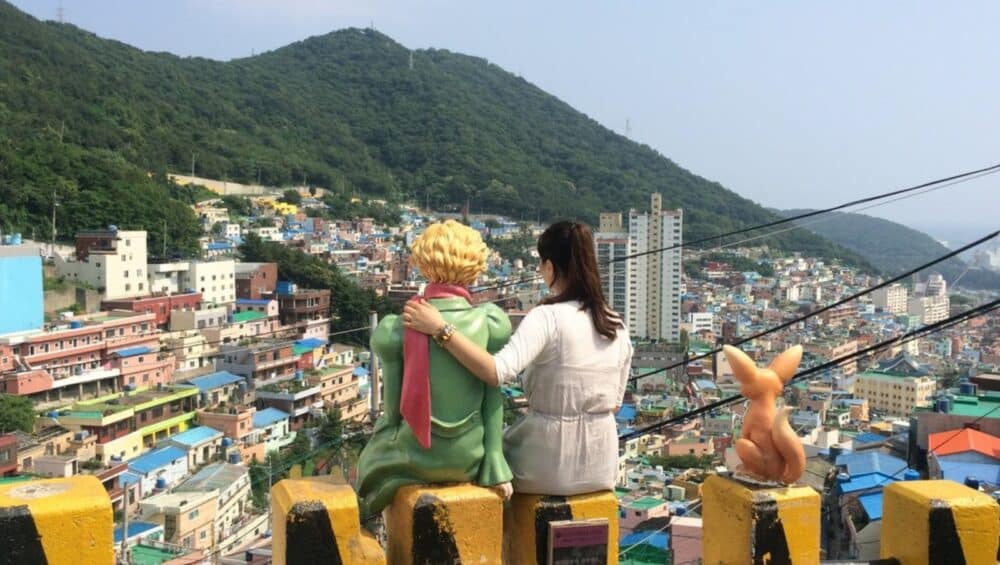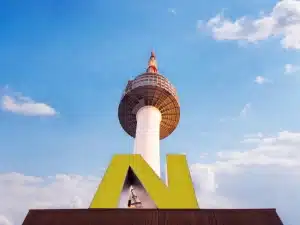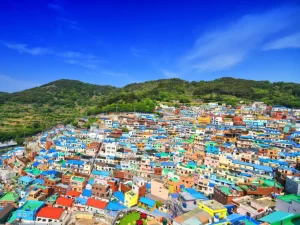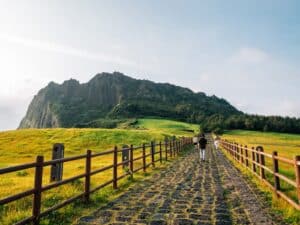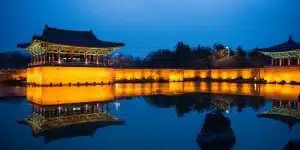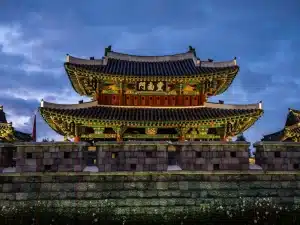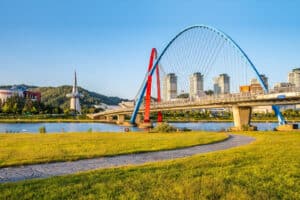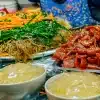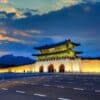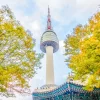South Korea is a country rich in culture and history, with a blend of modernity that makes it a fascinating destination for tourists. From bustling cities to stunning natural wonders, South Korea offers a wide range of attractions that cater to different interests. In this article, we’ll explore the top cities to visit in South Korea and what makes them special.
I. Introduction
Brief Overview of South Korea
South Korea is located in East Asia and is known for its vibrant culture, technology, and entertainment industry. It has a population of over 51 million people and has become a popular travel destination in recent years.
Why South Korea is a great travel destination?
South Korea offers a unique travel experience that combines traditional culture and modernity. The country has a rich history and heritage, which is reflected in its architecture, food, and festivals. Additionally, South Korea has a highly developed infrastructure, making it easy for tourists to navigate the country.
II. Seoul
Historical landmarks and cultural attractions
Gyeongbokgung Palace
Gyeongbokgung Palace is a royal palace located in the heart of Seoul. It was built in 1395 and is one of the most iconic landmarks in the city.
Changdeokgung Palace
Changdeokgung Palace is a UNESCO World Heritage Site that was built during the Joseon Dynasty. It is renowned for its beautiful gardens and traditional architecture.
National Museum of Korea
The National Museum of Korea is the largest museum in the country and houses over 220,000 artifacts. It offers a glimpse into Korea’s history and culture.
Find out: 9 Best Indian Restaurants in Seoul, South Korea
B. Shopping and entertainment
Myeong-dong
Myeong-dong is a popular shopping district in Seoul that offers a variety of shops, restaurants, and cafes. It’s a great place to shop for fashion, cosmetics, and souvenirs.
Gangnam district
Gangnam is a trendy district in Seoul that is known for its upscale shopping, nightlife, and entertainment. It’s a great place to experience the city’s modern vibe.
Namsan Tower
Namsan Tower is a popular tourist attraction that offers panoramic views of the city. It’s also a great place to enjoy a romantic evening with your loved one.
Book your south Korea tour package from here.
III. Busan
A. Beaches and scenic spots
Haeundae Beach
Haeundae Beach is one of the most popular beaches in South Korea and is located in Busan. It offers a long stretch of sand and crystal-clear waters.
Taejongdae Park
Taejongdae Park is a natural park that offers stunning views of the coastline. It’s also home to a lighthouse and a temple.
Gamcheon Culture Village
Gamcheon Culture Village is a colorful village that is known for its vibrant murals and street art. It’s a great place to explore on foot.
B. Cultural experiences
Jagalchi Fish Market
Jagalchi Fish Market is the largest fish market in Korea and offers a wide range of seafood. It’s a great place to try some of the local delicacies.
Busan Tower
Busan Tower is a landmark tower located in the heart of Busan. It offers stunning views of the city and is a great place to take photos.
Beomeosa Temple
Beomeosa Temple is a Buddhist temple located in the mountains of Busan. It’s a great place to experience the country’s spiritual side.
Read more blogs on South Korea Travel: What is South Korea most famous for?
IV. Jeju Island
A. Natural wonders
Seongsan Ilchulbong Peak
Seongsan Ilchulbong Peak is a volcanic peak that rises 182 meters above sea level, also known as “Sunrise Peak.” It offers a spectacular view of the sunrise and the vast ocean. Visitors can hike to the peak, which takes around 30 minutes, and enjoy the stunning view of the volcanic crater and the surrounding landscape.
Jeju Olle Trail
Jeju Olle Trail is a network of 26 hiking trails that cover a distance of 422 kilometers around the island’s coast. The trails provide a chance to explore Jeju Island’s natural beauty, including beaches, forests, mountains, and villages. The trails are well-marked, and visitors can choose a route that fits their fitness level and interests.
Hallasan National Park
Hallasan National Park is a UNESCO Biosphere Reserve and a popular hiking destination. The park is home to Hallasan, the highest mountain in South Korea, with an elevation of 1,950 meters. The park has various hiking trails, ranging from easy to difficult, and offers breathtaking views of the island’s volcanic landscape, waterfalls, and wildlife.
B. Cultural attractions
Jeju Folk Village Museum
Jeju Folk Village Museum is an open-air museum that showcases traditional Jeju Island life and culture. Visitors can see replicas of old Jeju houses, tools, and household items. There are also performances of traditional Jeju music and dance.
Haenyeo Museum
Haenyeo Museum is dedicated to the island’s famous female divers who gather seafood without any diving equipment. The museum exhibits the tools used by the divers, their traditional clothing, and their history. Visitors can also watch a performance of the divers in action.
Jeju Teddy Bear Museum
Jeju Teddy Bear Museum is a museum that displays various teddy bears from around the world. The museum also showcases teddy bears in different settings, such as history, art, and culture. Visitors can take photos with their favorite bears and buy souvenirs from the gift shop.
Explore more on Jeju: 4 Places to Visit on Jeju Island, South Korea
V. Gyeongju
A. Historical and Archaeological Sites
Bulguksa Temple
Bulguksa Temple is a UNESCO World Heritage site and one of the most famous temples in South Korea. It was built in the 8th century and is known for its intricate architectural details and beautiful natural surroundings. Visitors can explore the temple’s many halls, pagodas, and statues, as well as enjoy the scenic views of the surrounding mountains and valleys.
Seokguram Grotto
Seokguram Grotto is another UNESCO World Heritage site and is located on the slopes of Tohamsan Mountain. The grotto contains a large statue of Buddha and is considered one of the finest examples of Buddhist art in East Asia. Visitors can hike up to the grotto and admire the stunning views of the surrounding mountains and sea.
Gyeongju National Museum
Gyeongju National Museum is a must-visit destination for history buffs. The museum features a vast collection of artifacts and relics from the Silla dynasty, which ruled over Korea for nearly a thousand years. Visitors can learn about the rich cultural heritage of Korea and admire the many treasures on display, including pottery, paintings, and weapons.
B. Scenic Spots
Anapji Pond
Anapji Pond is a beautiful artificial pond located in the heart of Gyeongju. The pond was built during the Silla dynasty and features a number of pavilions, bridges, and gardens. Visitors can take a leisurely stroll around the pond and enjoy the tranquil atmosphere and stunning views.
Bomun Lake
Bomun Lake is a man-made lake that is surrounded by beautiful gardens, parks, and resorts. Visitors can take a boat ride on the lake or simply relax and enjoy the scenic views. The area around the lake is also home to a number of restaurants, cafes, and souvenir shops.
Yangdong Village
Yangdong Village is a traditional Korean village that has been well-preserved for centuries. The village features over 160 traditional houses, many of which are still inhabited by local residents. Visitors can explore the narrow alleys and admire the beautiful architecture of the houses, as well as learn about the daily life and culture of the local people.
Korea blogs: Unique Things To Do In Seoul
VI. Jeonju
A. Culinary Experiences
Jeonju Hanok Village
Jeonju Hanok Village is a traditional Korean village that is famous for its delicious food and beautiful architecture. Visitors can sample a variety of local dishes, such as bibimbap, kongnamul gukbap, and makgeolli, and explore the many hanok (traditional Korean houses) that have been converted into restaurants and cafes.
Bibimbap Museum
The Bibimbap Museum is a unique museum dedicated to Korea’s most famous dish – bibimbap. Visitors can learn about the history and culture of bibimbap, as well as try their hand at making their own bibimbap. The museum also features a gift shop where visitors can buy bibimbap-related souvenirs.
Nambu Market
Nambu Market is a bustling traditional market that is famous for its wide variety of fresh produce, seafood, and street food. Visitors can sample local delicacies such as bindaetteok (mung bean pancakes), kimbap (rice rolls), and tteokbokki (spicy rice cakes).
B. Cultural Attractions
Gyeonggijeon Shrine
Gyeonggijeon Shrine is a beautiful shrine dedicated to King Tae-jo, the founder of the Joseon dynasty. Visitors can admire the stunning architecture of the shrine and learn about the history and culture of the Joseon dynasty. The shrine also houses the portrait of King Tae-jo, which is considered one of the most important cultural treasures of Korea.
Omokdae and Imokdae
Omokdae and Imokdae are two historic pavilions located in the Jeonju Hanok Village. These pavilions offer a scenic view of the village and the surrounding mountains. Visitors can take a leisurely stroll through the village and admire the traditional Korean architecture of the hanok houses.
Jeonju Hyanggyo Confucian School
Jeonju Hyanggyo Confucian School is a historic school that was built during the Joseon dynasty. The school was used to educate the children of local aristocrats in Confucianism. Visitors can learn about the teachings of Confucianism and the traditional education system of Korea. The school also offers a peaceful and serene atmosphere, perfect for a quiet stroll.
Korea blog: The Best Time to Visit Korea: A Seasonal Guide
VII. Daegu
A. Historical sites
Donghwasa Temple
Donghwasa Temple is a Buddhist temple located on the outskirts of Daegu. It was built in the 9th century and is known for its stunning architecture, including the 17-meter tall statue of Buddha. Visitors can explore the temple grounds and experience the peaceful atmosphere of this sacred place.
Gyeongsang-gamyeong Park
Gyeongsang-gamyeong Park is a historic site that was once the provincial government office during the Joseon dynasty. It now serves as a cultural heritage site and features traditional buildings, gardens, and a museum.
Daegu Yangnyeongsi Museum of Oriental Medicine
Daegu Yangnyeongsi Museum of Oriental Medicine is a unique museum dedicated to traditional Korean medicine. Visitors can learn about the history and practice of oriental medicine, see a collection of medicinal herbs, and even participate in traditional treatments.
B. Shopping and entertainment
Seomun Market
Seomun Market is a bustling traditional market that has been in operation for over 100 years. Visitors can find a variety of goods, including food, clothing, and souvenirs. It’s a great place to experience local culture and pick up some unique items.
E-World
E-World is a theme park and entertainment complex that offers a range of activities for visitors of all ages. It includes a variety of rides, attractions, and performances, as well as shopping and dining options.
Suseong Lake
Suseong Lake is a popular destination for outdoor activities and relaxation. Visitors can take a leisurely stroll around the lake, rent a bike, or even take a boat ride. There are also plenty of restaurants and cafes nearby to enjoy a meal or a cup of coffee with a view.
Find out: Top 6 Rides at Lotte World in Korea
VIII. Daejeon
A. Science and technology attractions
National Science Museum
The National Science Museum in Daejeon is a must-visit destination for science enthusiasts. The museum has a vast collection of exhibits that showcase various aspects of science and technology. Visitors can explore interactive exhibits and participate in hands-on activities, making it a fun and educational experience for all ages.
Daedeok Science Town
Daedeok Science Town is a research and development hub in Daejeon, known for its cutting-edge technology and innovation. Visitors can take a tour of the town and learn about the latest advancements in science and technology.
Expo Science Park
Expo Science Park is an interactive science museum that offers a unique experience for visitors. The park has a variety of exhibits and activities that showcase different aspects of science and technology, including robotics, space exploration, and energy.
B. Cultural experiences
Hanbat Arboretum
Hanbat Arboretum is a peaceful oasis in the heart of the city, featuring a vast collection of plants and trees. Visitors can take a stroll along the winding paths and admire the natural beauty of the arboretum.
Yuseong Hot Springs
Yuseong Hot Springs is a popular destination for those seeking relaxation and rejuvenation. The hot springs are said to have therapeutic properties that can soothe aches and pains, making it a perfect retreat for travelers.
Daejeon Museum of Art
Daejeon Museum of Art is a contemporary art museum that showcases works from local and international artists. Visitors can explore a variety of exhibits and installations, making it a must-visit destination for art lovers.
Interested in South Korea Tour Packages:
IX. Frequently Asked Questions (FAQs)
A. What is the best time to visit South Korea?
The best time to visit South Korea is during the spring (April-June) and autumn (September-November) months when the weather is mild and comfortable. connect with us and our team will guide you through your korea tour package.
B. Is South Korea a safe travel destination?
Yes, South Korea is a safe travel destination. The crime rate is relatively low, and the country has a well-developed infrastructure that ensures the safety of travelers.
C. What is the currency used in South Korea?
The currency used in South Korea is the South Korean won (KRW).
D. Do I need a visa to visit South Korea?
It depends on your nationality. Citizens of some countries can enter South Korea without a visa for a limited period, while others need to apply for a visa in advance.
E. What are some cultural norms to be aware of in South Korea?
In South Korea, it is essential to show respect for elders and authority figures. Removing shoes before entering someone’s home or a temple is also a common practice. Bowing is a traditional greeting, and it is customary to use two hands when giving or receiving items. For more info: follow our instagram
Conclusion
In conclusion, South Korea is a vibrant and exciting travel destination that offers a unique blend of history, culture, and natural beauty. From the bustling streets of Seoul to the tranquil hot springs of Daejeon, there is something for everyone to explore and discover. So, pack your bags and embark on an unforgettable adventure to discover the hidden gems of South Korea.

